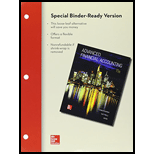
Concept explainers
a.
Concept introduction:
Consolidation entry: The basic consolidation entry removes the investment in parent company stock account and subsidiary’s
Which of the given companies G or R is parent company.
b.
Concept introduction:
Consolidation entry: The basic consolidation entry removes the investment in parent company stock account and subsidiary’s stockholders equity accounts. Consolidation is the process of combining the financials of subsidiary with financials of parent company. This is typically done when parent holds more than 50 percent of shares of another entity.
Percentage of owner ship parent R holds in subsidiary G
c.
Concept introduction:
Consolidation entry: The basic consolidation entry removes the investment in parent company stock account and subsidiary’s stockholders equity accounts. Consolidation is the process of combining the financials of subsidiary with financials of parent company. This is typically done when parent holds more than 50 percent of shares of another entity.
Amount to be reported without consolidating entry when net income for 20X7 is $70,000.
d.
Concept introduction:
Consolidation entry: The basic consolidation entry removes the investment in parent company stock account and subsidiary’s stockholders equity accounts. Consolidation is the process of combining the financials of subsidiary with financials of parent company. This is typically done when parent holds more than 50 percent of shares of another entity.
Increase or decrease in income to the non-controlling interest reported in 20X7 as a result of preceding consolidating entry
e.
Concept introduction:
Consolidation entry: The basic consolidation entry removes the investment in parent company stock account and subsidiary’s stockholders equity accounts. Consolidation is the process of combining the financials of subsidiary with financials of parent company. This is typically done when parent holds more than 50 percent of shares of another entity.
Preparation of elimination entry for consolidation worksheet on December 31 20X8.
Want to see the full answer?
Check out a sample textbook solution
Chapter 8 Solutions
LOOSE-LEAF Advanced Financial Accounting with Connect
- Can you help me solve this financial accounting question using valid financial accounting techniques?arrow_forwardSisu, Oliver and Jones are partners. They share profits and losses in the ratios 2/5,2/5 and 1/5 respectively. For the year ended 31 December 19x6 their capital accounts remained fixed at the following amounts Sisu R6000 Oliver R4000 Jones R2000 They have agreed to give each other 10 per cent per annum on their capital accounts. In addition to the above partnership salaries of R3000 for Oliver and R1000 for Jones are to be charged. The net profit of the partnership before taking any of the above into account was R25200. You are required to draw up the appropriation statement of the partnership for the year ended 31 December 19x6arrow_forwardPlease explain the solution to this general accounting problem using the correct accounting principles.arrow_forward
- Please explain the solution to this financial accounting problem using the correct financial principles.arrow_forwardPlease help me solve this financial accounting problem with the correct financial process.arrow_forwardRoach and Sulman own a grocery shop. Their first financial year ended on 31 December 19x0. The following balance were taken from the books on that date. Capital - Roach R60000, Suleman R48000 Partnership salaries - Roach R9000, Suleman R6000 Drawings - Roach R12860, Suleman R13400 The first net profit for the year was R32840 Interest on capital is to be allowed at 10% per year Profits and losses are to be shared equally. From the above, prepare the firms appropriation statement and the partners current accountsarrow_forward
- I am looking for the correct answer to this financial accounting problem using valid accounting standards.arrow_forwardI am trying to find the accurate solution to this financial accounting problem with appropriate explanations.arrow_forwardPlease provide the answer to this general accounting question using the right approach.arrow_forward
 Financial AccountingAccountingISBN:9781305088436Author:Carl Warren, Jim Reeve, Jonathan DuchacPublisher:Cengage Learning
Financial AccountingAccountingISBN:9781305088436Author:Carl Warren, Jim Reeve, Jonathan DuchacPublisher:Cengage Learning
